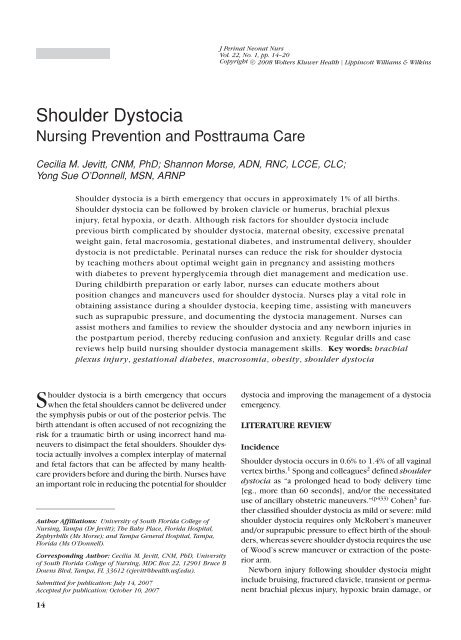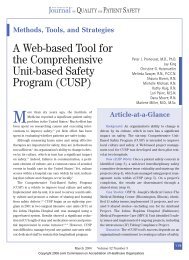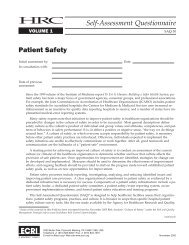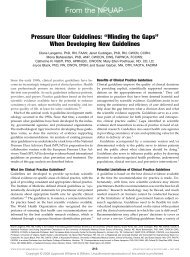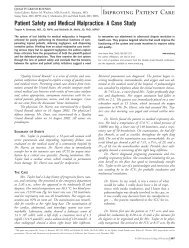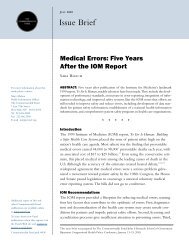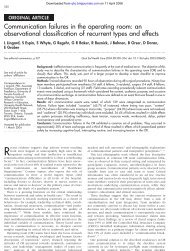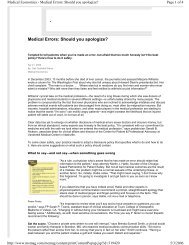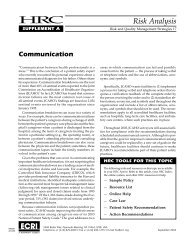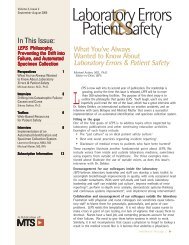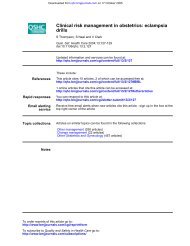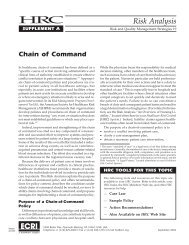Shoulder Dystocia - Lippincott Williams & Wilkins
Shoulder Dystocia - Lippincott Williams & Wilkins
Shoulder Dystocia - Lippincott Williams & Wilkins
Create successful ePaper yourself
Turn your PDF publications into a flip-book with our unique Google optimized e-Paper software.
J Perinat Neonat Nurs<br />
Vol. 22, No. 1, pp. 14–20<br />
Copyright c○ 2008 Wolters Kluwer Health | <strong>Lippincott</strong> <strong>Williams</strong> & <strong>Wilkins</strong><br />
<strong>Shoulder</strong> <strong>Dystocia</strong><br />
Nursing Prevention and Posttrauma Care<br />
Cecilia M. Jevitt, CNM, PhD; Shannon Morse, ADN, RNC, LCCE, CLC;<br />
Yong Sue O’Donnell, MSN, ARNP<br />
<strong>Shoulder</strong> dystocia is a birth emergency that occurs in approximately 1% of all births.<br />
<strong>Shoulder</strong> dystocia can be followed by broken clavicle or humerus, brachial plexus<br />
injury, fetal hypoxia, or death. Although risk factors for shoulder dystocia include<br />
previous birth complicated by shoulder dystocia, maternal obesity, excessive prenatal<br />
weight gain, fetal macrosomia, gestational diabetes, and instrumental delivery, shoulder<br />
dystocia is not predictable. Perinatal nurses can reduce the risk for shoulder dystocia<br />
by teaching mothers about optimal weight gain in pregnancy and assisting mothers<br />
with diabetes to prevent hyperglycemia through diet management and medication use.<br />
During childbirth preparation or early labor, nurses can educate mothers about<br />
position changes and maneuvers used for shoulder dystocia. Nurses play a vital role in<br />
obtaining assistance during a shoulder dystocia, keeping time, assisting with maneuvers<br />
such as suprapubic pressure, and documenting the dystocia management. Nurses can<br />
assist mothers and families to review the shoulder dystocia and any newborn injuries in<br />
the postpartum period, thereby reducing confusion and anxiety. Regular drills and case<br />
reviews help build nursing shoulder dystocia management skills. Key words: brachial<br />
plexus injury, gestational diabetes, macrosomia, obesity, shoulder dystocia<br />
<strong>Shoulder</strong> dystocia is a birth emergency that occurs<br />
when the fetal shoulders cannot be delivered under<br />
the symphysis pubis or out of the posterior pelvis. The<br />
birth attendant is often accused of not recognizing the<br />
risk for a traumatic birth or using incorrect hand maneuvers<br />
to disimpact the fetal shoulders. <strong>Shoulder</strong> dystocia<br />
actually involves a complex interplay of maternal<br />
and fetal factors that can be affected by many healthcare<br />
providers before and during the birth. Nurses have<br />
an important role in reducing the potential for shoulder<br />
Author Affiliations: University of South Florida College of<br />
Nursing, Tampa (Dr Jevitt); The Baby Place, Florida Hospital,<br />
Zephyrhills (Ms Morse); and Tampa General Hospital, Tampa,<br />
Florida (Ms O’Donnell).<br />
Corresponding Author: Cecilia M. Jevitt, CNM, PhD, University<br />
of South Florida College of Nursing, MDC Box 22, 12901 Bruce B<br />
Downs Blvd, Tampa, FL 33612 (cjevitt@health.usf.edu).<br />
Submitted for publication: July 14, 2007<br />
Accepted for publication: October 10, 2007<br />
14<br />
dystocia and improving the management of a dystocia<br />
emergency.<br />
LITERATURE REVIEW<br />
Incidence<br />
<strong>Shoulder</strong> dystocia occurs in 0.6% to 1.4% of all vaginal<br />
vertex births. 1 Spong and colleagues 2 defined shoulder<br />
dystocia as “a prolonged head to body delivery time<br />
[eg., more than 60 seconds], and/or the necessitated<br />
use of ancillary obstetric maneuvers.” (p433) Cohen 3 further<br />
classified shoulder dystocia as mild or severe: mild<br />
shoulder dystocia requires only McRobert’s maneuver<br />
and/or suprapubic pressure to effect birth of the shoulders,<br />
whereas severe shoulder dystocia requires the use<br />
of Wood’s screw maneuver or extraction of the posterior<br />
arm.<br />
Newborn injury following shoulder dystocia might<br />
include bruising, fractured clavicle, transient or permanent<br />
brachial plexus injury, hypoxic brain damage, or
<strong>Shoulder</strong> <strong>Dystocia</strong> 15<br />
death. Maternal morbidity following shoulder dystocia<br />
can include postpartum hemorrhage, perineal lacerations<br />
and bruising, and pelvic hematoma.<br />
SHOULDER DYSTOCIA CAUSES<br />
When weight exceeds 4000 g, the fetal body assumes<br />
more adult proportions with the width of the fetal<br />
shoulders exceeding the biparietal diameter of the<br />
head. The fetal head is born but the anterior shoulder<br />
becomes trapped behind the symphysis pubis or<br />
the posterior shoulder catches on the sacral promontory.<br />
Stretching of the brachial plexus can happen during<br />
maternal pushing, during vacuum extractor or forceps<br />
use, or during birth hand maneuvers. Stretching<br />
of the brachial plexus nerves can cause a temporary<br />
nerve conduction deficit called neuropraxia. 4,5 Severe<br />
stretching may avulse brachial plexus nerve roots from<br />
the spinal cord causing permanent loss of arm function.<br />
Cervical nerves 5 through 8 and T1 may be involved.<br />
Future function of the fingers, hand, and arm will depend<br />
on which nerves are damaged.<br />
The clavicle or humerus may fracture during attempts<br />
to relieve the shoulder dystocia. These are temporary<br />
injuries and heal with splinting of the arm. An<br />
arm is splinted by positioning it across the chest with<br />
the hand resting under the opposite shoulder, held in<br />
place with a Velcro strap or a length of fabric wrapped<br />
around the trunk and pinned in place.<br />
Brachial plexus injury is the morbidity most often<br />
associated with shoulder dystocia and is a common<br />
source of liability claims. 6 The incidence of brachial<br />
plexus injury ranges from 0.4 to 1.5 per 1000 births. 7,8<br />
Fifty percent of brachial plexus injuries occur without<br />
shoulder dystocia. 1 Brachial plexus injuries have occurred<br />
after cesarean delivery. 1 Brachial plexus injuries<br />
to the posterior shoulder have also been documented. 1<br />
Postcesarean and posterior arm injuries raise the question<br />
of the relationship of maternal pushing efforts to<br />
the stretching of the brachial plexus.<br />
Most newborns recover spontaneously from brachial<br />
plexus injury with physical therapy. 7 Only 5% to 22% of<br />
infants have permanent injury. 7,8 Spontaneous elbow<br />
flexion at 3 months is a favorable sign for recovery without<br />
corrective surgery. 8 Infants who need surgical repair<br />
rarely have full return of neurologic function. 9<br />
<strong>Shoulder</strong> dystocia with permanent arm or brain injury<br />
or newborn death is a frequent source of malpractice<br />
claims. 6,10 Nurses working together with other professionals<br />
during prenatal and intrapartum care can reduce<br />
the incidence and improve the outcomes of shoulder<br />
dystocia (Table 1).<br />
ANTENATAL EDUCATION TO DECREASE<br />
SHOULDER DYSTOCIA RISKS<br />
Nurses are an important source of health information<br />
for expectant mothers. The office nursing staff may<br />
provide the most care continuity for women as obstetricians<br />
and midwives rotate between the prenatal<br />
office and labor and delivery. Three risk factors for<br />
shoulder dystocia—obesity, excessive prenatal weight<br />
gain, and diabetes—are all related to another risk factor,<br />
macrosomia. 1,10<br />
Weight management<br />
With 30% of American childbearing-age women obese<br />
before pregnancy, 14 weight management education<br />
may be the most important tool a nurse can provide<br />
to reduce the threat of shoulder dystocia. Assess overweight<br />
and obesity at the first prenatal visit. An accurate<br />
height and weight measurement is an essential<br />
part of the prenatal record. Measuring height, preferably<br />
with a stadiometer (a wall mounted height measure),<br />
is more accurate than maternal height recall.<br />
Body mass index (BMI) graphs, calculation wheels, or<br />
computer calculator programs should be readily available.<br />
Many adult women have never had their BMI calculated.<br />
This presents the nurse with an opportunity<br />
to teach how excess weight can influence pregnancy,<br />
the birth, and the future health of both mother and<br />
infant.<br />
Body mass index determination offers a more precise<br />
measure of weight related to height and is most<br />
useful in advising an adequate but not excessive prenatal<br />
weight gain. 15,16 The Institute of Medicine issued<br />
recommended prenatal weight gains in 1990 that are<br />
based on pregravid BMI (Table 2). 11 Women of normal<br />
weight, for example, are advised to gain 25 to 35<br />
lb for a healthy pregnancy and obese women at least<br />
15 lb. Using these tailored recommendations helps<br />
women avoid unnecessary weight gain, which predisposes<br />
them to a macrosomic infant and maternal obesity<br />
in later life.<br />
The recommended weight gain should be documented<br />
on the prenatal record so that all prenatal care<br />
providers use the same reference point. A maternal<br />
BMI of 30 or more should be documented on the prenatal<br />
record problem list as obesity is a risk factor<br />
for many perinatal problems, including gestational diabetes,<br />
preeclampsia, stillbirth, macrosomia, prolonged<br />
labor, shoulder dystocia, and cesarean section. 1,10 Documenting<br />
BMI indicates more about the risks of obesity<br />
than the labels obese or morbidly obese.<br />
Weight gain should be measured at each prenatal visit<br />
and assessed for adequacy. Graphs are available that
16 Journal of Perinatal & Neonatal Nursing/January–March 2008<br />
Table 1. Perinatal nursing interventions in shoulder dystocia<br />
Prenatal<br />
Measure height and weight at first prenatal visit. Calculate Body mass index (BMI) and document in prenatal record<br />
Teach weight gain recommendations based on Institute of Medicine guidelines 11<br />
Provide facts about the risks of excess weight gain, uncontrolled diabetes, and shoulder dystocia 1;10<br />
Advise nutritious foods using national guidelines 11;12<br />
Ensure routine screening for diabetes in pregnancy. Screen obese women in the first and third trimesters 13<br />
Document fetal growth and/or estimated fetal weight at each prenatal visit. Communicate fetal weights that may exceed 4000 g<br />
to the prenatal care provider<br />
Educate women about shoulder dystocia positions and maneuvers during childbirth preparation<br />
Perform regular team shoulder dystocia drills<br />
Intrapartum<br />
Ensure that height, pregravid weight, current weight, BMI, and assessment of pelvic adequacy are documented in the health<br />
record<br />
Assess maternal history for shoulder dystocia risk factors<br />
Palpate and document fetal position. Document estimated fetal weight and/or fundal height.<br />
Notify birth attendant of inadequate progression of dilatation and descent in labor.<br />
Check and have ready emergency resuscitation equipment.<br />
During shoulder dystocia<br />
Know whom to summon when the birth attendant asks for help<br />
Know the correct use of McRobert’s maneuver and suprapubic pressure<br />
Avoid the use of fundal pressure<br />
Record times of head delivery, head-to-body delivery interval, times when help was requested, and arrival times of other<br />
personnel<br />
Postpartum<br />
Record any physical abnormalities on the newborn such as bruising or lack of arm muscle tone. Notify nursery nurses and<br />
pediatricians<br />
Acknowledge mother’s and family’s emotions<br />
Provide factual information<br />
Ensure that documentation of the shoulder dystocia by all birth personnel is correct and consistent<br />
Notify organizational risk manager of shoulder dystocia. Participate in case review<br />
Teach mother and family care of the newborn. Assist with referrals for physical therapy or neurologists<br />
plot actual weight gain against a healthy gain. These<br />
can be useful in helping women visualize their weight<br />
changes. Many nurses hesitate to discuss weight with<br />
women for fear of insulting them. A focus on risk prevention<br />
and the best future health for mothers and newborns<br />
shifts the discussion from clothing size to risk<br />
reduction that is under individual control. Nurses can<br />
provide obese women with resources such the Centers<br />
for Disease Control and Prevention’s 5 a Day Program 12<br />
that encourages 5 servings of fruits and vegetables a<br />
day. Fruits and vegetables provide minerals, vitamins,<br />
and filling fiber, while being less calorie dense than processed<br />
foods.<br />
Women who gain weight in excess of the Institute<br />
of Medicine recommended levels should receive<br />
counseling about food intake and activity. 15,16 Excess<br />
weight gain provides calories for excessive fetal<br />
growth. Women with large weight gains should be seen<br />
Table 2. 1990 Institute of Medicine recommended prenatal weight gains a<br />
Recommended weight gain<br />
Height for weight category BMI b range kg lb<br />
Underweight women 29.9 At least 6.0 At least 15<br />
a Used with permission from the Institute of Medicine. 11<br />
b Body mass index, calculated as (weight in pounds)/(height in inches) 2 × 703.
<strong>Shoulder</strong> <strong>Dystocia</strong> 17<br />
more often during pregnancy, every 2 weeks instead of<br />
monthly, to provide more frequent nutrition coaching.<br />
They many benefit from a referral to a nutritionist. Nutrition<br />
counseling for some women may be obtained<br />
through the Women, Infants and Children’s Supplemental<br />
Nutrition Program (WIC). Obese women may<br />
qualify for WIC, for example, by being anemic. Women<br />
who are overweight or obese demonstrate periods of<br />
excess caloric intake, not necessarily adequate nutrient<br />
ingestion.<br />
Diabetes in pregnancy<br />
Obesity and excessive weight gain are risk factors<br />
for gestational diabetes. 13 Pregestational and gestational<br />
diabetes complicated by obesity, poor glycemic<br />
control, or excessive weight gain increase risk for<br />
shoulder dystocia. 1,17,13 All pregnant women should<br />
be screened for diabetes during pregnancy by using<br />
national standards. 13 The 2005 American College of<br />
Obstetricians and Gynecologists standards for obesity<br />
management during pregnancy advise consideration of<br />
gestational diabetes screening at the first-trimester firstprenatal<br />
visit with repeated screening later in pregnancy<br />
if the first screen is within a reference range. 13<br />
The prenatal nurse can ensure that these guidelines<br />
are integrated into practice and that abnormal screens<br />
are followed by 3-hour glucose testing and treatment<br />
as needed. Testing, treatment plans, and blood glucose<br />
records should be copied into the prenatal record so<br />
that all providers can assess progress with glucose control.<br />
If diabetes management is provided by a perinatologist<br />
or diabetologist outside of the prenatal practice,<br />
the nurse can enhance communication between<br />
practices by seeing that both practices have copies of<br />
laboratory values, visit records, and consultation summaries.<br />
These complete records should also be available<br />
in the prenatal records that are used for the labor<br />
and delivery record.<br />
Macrosomia<br />
Regular fundal height assessment during prenatal visits<br />
documents fetal growth and can be a screen for<br />
macrosomia. 17 Estimated fetal weight based on clinical<br />
palpation including Leopold’s maneuvers is as accurate<br />
as ultrasound estimation of fetal weight 17 ; therefore,<br />
nurses should practice their palpation skills and<br />
have confidence in their ability to estimate fetal size.<br />
The estimated weight of fetuses with fundal heights<br />
greater than 40 cm should be measured carefully. Fetal<br />
chest circumferences equaling or exceeding fetal head<br />
circumferences measured by ultrasound may indicate<br />
shoulder dystocia risk. 3 When estimated fetal weight<br />
exceeds 5000 g in women without diabetes and 4500 g<br />
in women with diabetes, the prenatal care provider<br />
needs to determine whether an induction of labor or<br />
elective cesarean birth is indicated and whether a plan<br />
has been made with the mother for the timing and manner<br />
of birth. 1,18<br />
PRIOR SHOULDER DYSTOCIA<br />
A previous shoulder dystocia with or without brachial<br />
plexus injury should be recorded on the prenatal problem<br />
list. 10 A prior shoulder dystocia increases the risk<br />
for a subsequent shoulder dystocia (9.8%–16.7%), although<br />
most subsequent births do not involve shoulder<br />
dystocia. 19 Women who have had a prior shoulder dystocia<br />
need careful informed consent on prenatal weight<br />
gain, the risk of recurrence, and birth options. 1,10 The<br />
prenatal care provider should form a plan for time and<br />
place of birth with the mother that is documented in<br />
the prenatal record. The nurse can help prepare the<br />
mother for scheduled births by teaching about induction<br />
of labor or presurgical routines.<br />
CHILDBIRTH PREPARATION<br />
Nurses who teach childbirth preparation can prepare<br />
mothers and their families for the common maneuvers<br />
used in shoulder dystocia management without scaring<br />
the family with worst-case complications. 10 The childbirth<br />
preparation nurse can say,<br />
Some large newborns are tight fits through the vagina. The<br />
labor and delivery nurses may help you pull your legs back<br />
to your chest to help move the pubic bone over the baby’s<br />
shoulder. A nurse might also push down just above your pubic<br />
bone to nudge the baby’s shoulder under the bone. Sometimes<br />
the midwife or doctor might put a hand behind the<br />
baby’s back to push it sideways into a large part of the pelvis<br />
so the shoulders move down.<br />
Mothers can practice McRobert’s maneuver in class by<br />
pulling their legs to their chests while sitting on the<br />
floor resting against their seated coaches. The childbirth<br />
preparation teacher can demonstrate suprapubic<br />
pressure on a recumbent mother without using any<br />
pressure.<br />
INTRAPARTUM NURSING PREVENTION<br />
OF SHOULDER DYSTOCIA<br />
Risk assessment<br />
Although shoulder dystocia is unpredictable, the labor<br />
admission history and physical examination give the<br />
labor nurse the opportunity to recognize risk factors
18 Journal of Perinatal & Neonatal Nursing/January–March 2008<br />
for shoulder dystocia. Pregravid height, weight, and<br />
BMI should be included in the health record. 10 Estimated<br />
fetal weight or fundal height should be assessed<br />
and recorded at labor admission along with clinical<br />
pelvimetry and a determination of clinical adequacy<br />
for labor. 10 Although these elements of the physical<br />
examination are most often done by the midwife or<br />
physician, the labor nurse can remind the birth attendant<br />
if items are missing from the admission record.<br />
The labor nurse might also advocate for the use of a<br />
standard labor admission form or electronic template<br />
that contains blank fields for estimated fetal weight,<br />
fundal height, and assessment of pelvic adequacy.<br />
Blank fields remind clinicians to document these elements<br />
of assessment.<br />
Fetal position should be palpated and documented<br />
as part of the nursing labor admission. Palpation may<br />
be difficult if the mother is obese. Location of the fetal<br />
heart tones may assist in determining fetal position.<br />
Knowing the location of the fetal back will assist the<br />
nurse in giving the most effective suprapubic pressure<br />
if needed during the birth.<br />
Family and environmental preparation<br />
Early labor gives the nurse another chance to prepare<br />
the family for shoulder dystocia management. The art of<br />
prevention nursing is in recognizing the risk factors for<br />
shoulder dystocia, being physically and mentally prepared<br />
for the emergency, but conveying only optimism<br />
and confidence to the parents. The nurse can have the<br />
mother and family practice McRobert’s maneuver. The<br />
nurse can also assist the mother in moving to her left<br />
side or onto all fours if the birth attendant uses these<br />
positions during shoulder dystocia maneuvers. 10 The<br />
nurse can also use early labor to review shoulder dystocia<br />
assistance preferences with the birth attendant.<br />
The nurse anticipates if the birth attendant will want<br />
suprapubic pressure, changes in the birth bed configuration,<br />
or the mother assisted into a left lateral position<br />
if a shoulder dystocia occurs.<br />
Since even small infants can have a shoulder dystocia,<br />
a well-prepared labor nurse will have each birth<br />
room ready for this emergency. Resuscitation equipment<br />
should be in place and working. A stool for nurses<br />
to stand on during suprapubic pressure should be near<br />
the bed.<br />
Although there are conflicting reports of the relationship<br />
of prolonged labors and shoulder dystocia, 1<br />
protracted labors are risk factors for a number of maternal<br />
and fetal morbidities and should be managed attentively.<br />
Extra caution is warranted when preparing<br />
for a forceps or vacuum-assisted birth especially when<br />
multiple risk factors for shoulder dystocia and brachial<br />
plexus injury coexist. 19 Instrumental births are associated<br />
with shoulder dystocia. 1,19<br />
NURSES’ ACTIONS DURING A SHOULDER<br />
DYSTOCIA<br />
Although the midwife or physician will perform the<br />
maneuvers to dislodge an impacted shoulder, the labor<br />
nurses provide essential support measures. To act efficiently<br />
when seconds matter, nurses must thoroughly<br />
understand the safety measures employed during a<br />
shoulder dystocia. <strong>Shoulder</strong> dystocia drills done with<br />
the regularity of fire or code blue drills provide nursing<br />
with the practice necessary to act automatically during<br />
a dystocia. 20<br />
The midwife or physician will request that the nurse<br />
summon additional help. Other personnel might include<br />
additional nursing staff, a resuscitation team from<br />
the nursery or respiratory therapy, or another midwife<br />
or physician. If the mother is semisitting for the<br />
birth, nurses will be expected to assist the mother into<br />
McRobert’s position by flexing the maternal thighs toward<br />
the maternal chest. McRobert’s maneuver slides<br />
the pubic bone over the anterior shoulder. 20 It is not<br />
useful as shoulder dystocia prophylaxis and should be<br />
employed only once a dystocia is evident. 21<br />
If McRobert’s maneuver does not dislodge the dystocia,<br />
the birth attendant will request suprapubic pressure.<br />
Optimal suprapubic pressure is accomplished by<br />
placing a clenched fist or the heel of the hand behind<br />
the anterior shoulder and pushing the shoulder<br />
toward the fetal chest and down. 20 This pushes the<br />
shoulder into the larger oblique diameter of the pelvis<br />
and presses it under the suprapubic bone. Adequate<br />
force must accompany suprapubic pressure. For the<br />
most effective strength, the nurse may place the second<br />
hand on top of the clenched fist and with both<br />
elbows straightened lean into the maternal abdomen.<br />
Short nurses may need to stand on a stool to have sufficient<br />
height and reach for the maneuver.<br />
If McRobert’s maneuver and suprapubic pressure do<br />
not release the shoulder, the birth attendant may use<br />
Rubin’s maneuver, Wood’s screw maneuver, or several<br />
other techniques. 1,10,20,22 There is no correct order or<br />
superior order for maneuver use; however, fundal pressure<br />
should be avoided. 1,20 Fundal pressure is steady<br />
pressure exerted by one hand pushing on the uterine<br />
fundus, assisting movement of the fetus down the<br />
birth canal. It may cause or further aggravate a shoulder<br />
dystocia. 1,20 The perinatal nurse has the right to<br />
refuse an order to do fundal pressure during a shoulder
<strong>Shoulder</strong> <strong>Dystocia</strong> 19<br />
dystocia. 1,20 <strong>Shoulder</strong> dystocia results from shoulder<br />
bones impacted against the pubic bone or the sacral<br />
promontory, not against soft tissue; therefore, an episiotomy<br />
does not improve outcomes and is not a necessary<br />
component of shoulder dystocia management. 10,23<br />
One nurse should become the scribe and timekeeper<br />
during a shoulder dystocia. Documentation of<br />
the time the shoulder dystocia started, head-to-body<br />
delivery time, and the time other providers, such<br />
as a nursery resuscitation team, arrived should be<br />
noted by the nurse. 10 The Association of Women’s<br />
Health, Obstetric, and Neonatal Nurses (AWHONN)<br />
recommends a narrative summary that shows a “logical<br />
step-by-step approach to relieving the affected<br />
shoulder.” 20(p8) AWHONN cautions that recorded times<br />
must be accurate. 20<br />
A resuscitation area should be ready for the newborn.<br />
Any resuscitation needed and Apgar scores should be<br />
recorded by nursing. An arm that is limp, unmoving,<br />
and extended with absent reflexes indicates brachial<br />
plexus injury. 20 Any bruising of the newborn and limitations<br />
in arm movement should be recorded in the<br />
nurses’ immediate newborn assessment. The nurse<br />
must communicate these findings to the midwife or<br />
physician and the nursing staff receiving the newborn<br />
for postpartum care.<br />
Once the newborn and mother are settled and<br />
starting postpartum recovery, nurses should complete<br />
documentation and review it for consistency with the<br />
documentation of other providers. If, for example,<br />
the provider’s note says there was no episiotomy<br />
but a second-degree laceration and the nurses’ labor<br />
summary says there was an episiotomy, the documentation<br />
must be reconciled for accuracy. Electronic fetal<br />
monitoring time and comment recordings are another<br />
potential source of discrepancy with the medical<br />
record. 20<br />
POSTPARTUM CARE<br />
In the past, physicians, midwives, and nurses avoided<br />
discussing the shoulder dystocia event or prognosis<br />
for fear of receiving blame for mismanagement and increasing<br />
the risk of a negligence claim. Immediate dialogue<br />
following the shoulder dystocia can maximize<br />
effective communication, which can minimize anger<br />
and frustration for the mother and family. 24,25 Debriefing<br />
offers the opportunity to explain the event to the<br />
mother who may not remember or understand what<br />
occurred. Vandekkieft 26 uses an ABCDE (Advance,<br />
Build, Communicate, Deal, Encourage) approach that<br />
includes Advance preparation (know relevant clinical<br />
information). Build a therapeutic environment by determining<br />
what the patient wants and needs to know<br />
and discuss with supportive family members present.<br />
Communicate effectively by being frank but compassionate<br />
and avoiding medical jargon. The nurse further<br />
deals with patient and family reactions allowing time<br />
for tears, anger, and silence and by encouraging and<br />
validating emotions.<br />
The pediatric staff should discuss medical follow-up<br />
with the family so they can anticipate home physical<br />
therapy and additional physician visits. Mothers who<br />
have had a shoulder dystocia need to be informed that<br />
the risk of shoulder dystocia in subsequent pregnancies<br />
is increased. 19 Nursing staff may link mothers with social<br />
or chaplaincy services for extra support. 27<br />
Following a shoulder dystocia with brachial plexus<br />
injury, the nursing staff should contact the organizational<br />
risk manager. The risk manager will assist the<br />
staff with documentation and communication between<br />
providers, the mother, and family. The risk manager can<br />
lead a review of the dystocia management. The purpose<br />
of the case review is not to assign blame but to determine<br />
what measures were successful and what steps<br />
might be refined or changed. The case review should<br />
be attended by anyone present at the birth. This increases<br />
information about the event and potential improvements<br />
to shoulder dystocia management.<br />
The risk for postpartum hemorrhage increases following<br />
a shoulder dystocia. 1 The fundus should be<br />
palpated to assess uterine contraction at least every<br />
15 minutes during the first postpartum hour. Early<br />
newborn breast-feeding increases endogenous maternal<br />
oxytocin to decrease postpartum bleeding. In the<br />
absence of breast-feeding, vigilant assessment and documentation<br />
of maternal blood loss with exogenous<br />
pitocin use can limit maternal blood loss. Perineal<br />
trauma such as bruising and lacerations is common following<br />
a shoulder dystocia. Ice packs applied to the<br />
perineum immediately postpartum reduce edema and<br />
perineal pain. After 24 hours, pain relief may be more<br />
effective using warm sitz baths.<br />
The newborn with a fractured clavicle or humerus<br />
may wear a cloth sling to splint the injured arm. Recovery<br />
is spontaneous. Approximately 80% of brachial<br />
plexus injuries heal over 3 to 6 months postpartum. 7,8<br />
Newborns who lack spontaneous arm movement or<br />
show no improvement in 4 to 6 weeks postpartum<br />
should be referred to pediatric neurologists for<br />
evaluation. 8 Demonstrating any special arm care and<br />
assessing parental comfort with that care are essential<br />
components of newborn discharge planning. Parents<br />
need to understand any newborn referrals and be able<br />
to schedule the appointments.
20 Journal of Perinatal & Neonatal Nursing/January–March 2008<br />
CONCLUSION<br />
<strong>Shoulder</strong> dystocia is traditionally viewed as a labor<br />
emergency that is managed by the birth attendant.<br />
However, perinatal nurses can work with mothers<br />
to reduce the risk of shoulder dystocia during both<br />
the prenatal and intrapartum periods. Education and<br />
practice in assisting with the management of a shoulder<br />
dystocia can improve outcomes for the newborn<br />
and mother. Perinatal nurses can ease the transition<br />
between birthplace and home by preparing mothers<br />
and families for the care of the newborn with a brachial<br />
plexus injury. Actions provided by perinatal nurses are<br />
essential in reducing the risk of shoulder dystocia and<br />
improving the outcomes following a shoulder dystocia<br />
throughout pregnancy and birth.<br />
REFERENCES<br />
1. American College of Obstetricians & Gynecologists<br />
(ACOG). <strong>Shoulder</strong> <strong>Dystocia</strong>. Washington, DC: ACOG<br />
Practice Bulletin #40;2002:1–5.<br />
2. Spong CY, Beall M, Rodrigues D, Ross MG. An objective<br />
definition of shoulder dystocia: prolonged head-to-body<br />
delivery intervals and/or the use of ancillary obstetric<br />
maneuvers. Obstet Gynecol. 1995;86(3):433–436.<br />
3. Cohen B, Penning S, Ansley D, Porto M, Garite T. The incidence<br />
and severity of shoulder dystocia correlates with a<br />
sonographic measurement of asymmetry in patients with<br />
diabetes. Am J Perinatol. 1999;16(4):197–201.<br />
4. Pollack R, Buchman A, Yaffe H, Divon M. Obstetrical<br />
brachial palsy: pathogenesis, risk factors, and prevention.<br />
Clin Obstet Gynecol. 2000;43(2):236–246.<br />
5. Dunham E. Obstetrical brachial plexus palsy. Orthop<br />
Nurs. 2003;22(2):106–116.<br />
6. Jennett R, Tarby T, Krauss R. Erb’s palsy contrasted with<br />
Klumpke’s and total palsy: different mechanisms are involved.<br />
Am J Obstet Gynecol. 2002;186(6):1216–1220.<br />
7. Donnelly V, Foran A, Murphy J, McFarland P, Keane D,<br />
O’Herlihy C. Neonatal brachial plexus palsy: an unpredictable<br />
injury. Am J Obstet Gynecol. 2002;187(5):1209–<br />
1212.<br />
8. Harele M, Gilbert A. Management of complete obstetric<br />
brachial plexus lesions. J Pediatr Orthop. 2004;<br />
24(2):194–200.<br />
9. Dodds S, Wolfe S. Perinatal brachial plexus palsy. Curr<br />
Opin Pediatr. 2000;12(1):40–47.<br />
10. Jevitt C. <strong>Shoulder</strong> dystocia: etiology, risk factors, and<br />
management. J Midwifery Womens Health. 2005;50:<br />
485–497.<br />
11. Centers for Disease Control and Prevention. 5 a day program.<br />
http://www.cdc.gov/nccdphp/dnpa/5ADay/. Accessed<br />
July 3, 2007.<br />
12. Institute of Institute of Medicine Subcommittee on Nutritional<br />
Status and Weight Gain during Pregnancy. Nutrition<br />
During Pregnancy. Institute of Medicine. Washington,<br />
DC: National Academy Press; 1990.<br />
13. American College of Obstetricians and Gynecologists<br />
(ACOG). Obesity in Pregnancy. ACOG Technical Bulletin.<br />
Washington, DC: ACOG; 2005.<br />
14. Centers for Disease Control and Prevention. Overweight<br />
and obesity: childhood overweight: overweight prevalence.<br />
http://www.cdc.gov/nccdphp/dnpa/obesity/<br />
trend/index.htm. Accessed July 3, 2007.<br />
15. Cogswell ME, Serdula MK, Hungerford DW, Yip R. Gestational<br />
weight gain among average-weight and overweight<br />
women—what is excessive? Am J Obstet Gynecol.<br />
1995;172(2, pt 1):705–712.<br />
16. Bianco S, Smilen S, Davis Y, Lopez S, Lapinski R, Lockwood<br />
C. Pregnancy outcome and weight gain recommendations<br />
for the morbidly obese woman. Obstet Gynecol.<br />
1998;91(1):97–102.<br />
17. American College of Obstetricians & Gynecologists<br />
(ACOG). Fetal Macrosomia. Washington, DC: ACOG<br />
Practice Bulletin # 22;2000:1–11.<br />
18. Oral E, Cagdas A, Gezer A, Kaleli S, Aydinli K, Ocer F.<br />
Perinatal and maternal outcomes of fetal macrosomia.<br />
Eur J Obstet Gynecol Reprod Biol. 2001;99(2001):161–<br />
171.<br />
19. Gherman G, Chauhan S, Ouzounian J, Lerner H, Gonik<br />
B, Goodwin M. <strong>Shoulder</strong> dystocia: the unpreventable obstetric<br />
emergency with empiric management guidelines.<br />
Am J Obstet Gynecol. 2006;195:657–672.<br />
20. Association of Women’s Health, Obstetric and Neonatal<br />
Nurses. Perinatal Nursing. Philadelphia, PA: <strong>Lippincott</strong>,<br />
<strong>Williams</strong> & <strong>Wilkins</strong>; 2008.<br />
21. Beall M, Spong C, Ross M. A randomized controlled trial<br />
of prophylactic maneuvers to reduce head-to-body delivery<br />
time in patients at risk for shoulder dystocia. Obstet<br />
Gynecol. 2003;102(1):31–35.<br />
22. Ramsey P, Ramin K, Field C, Rayburn W. <strong>Shoulder</strong> dystocia:<br />
rotational maneuvers revisited. J Reprod Med.<br />
2000;45(2):85–88.<br />
23. Gurewitsch E, Donithan M, Stallings S, et al. Episiotomy<br />
versus fetal manipulation in managing severe shoulder<br />
dystocia: a comparison of outcomes. Am J Obstet Gynecol.<br />
2004;191:911–916.<br />
24. Woods J, Rozovsky F. What Do I say? Communicating<br />
Intended or Unanticipated Outcomes in Obstetrics. San<br />
Francisco: Jossey-Bass; 2003.<br />
25. Barnett M. Effect of breaking bad news on patients’ perceptions<br />
of doctors. J R Soc Med. 2002;95:343–347.<br />
26. Vandekieft G. Breaking the bad news. Am Fam Physician.<br />
2001;64(12):1975–2001.<br />
27. Kwek K, Yeo G. <strong>Shoulder</strong> dystocia and injuries: prevention<br />
and management. Curr Opin Obstet Gynecol.<br />
2006;18:123–128.


